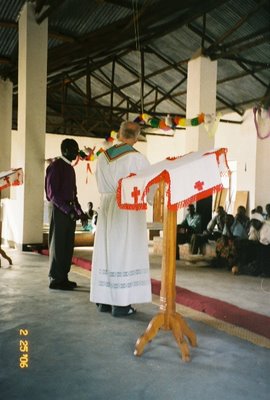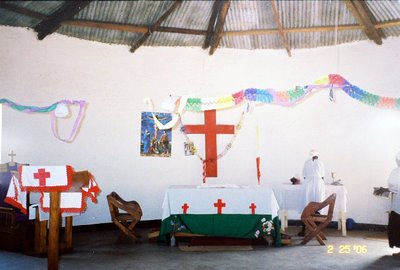It’s embarrassing to me to acknowledge this. But after a mere 3 weeks, I am not sure what the schedule of services was in Lui that Sunday. I know they had multiple services. I believe they had three services. I can’t recall what the first service was, but I do recall that Rick was the only one of our group who got himself up and at ‘em to attend all the services.
The second service (which all of us attended) was their English-language service. But it was not just native-English-speakers who attend. Lots of the Moru attend too. I wonder if this is because so many of the folks in Lui are working to improve their English-speaking skills.
 Father Bob got the distinction of getting to preach at that service. I think he had a little more than 12 hours notice of this assignment! This was taken as Bishop Bullen was introducing him.
Father Bob got the distinction of getting to preach at that service. I think he had a little more than 12 hours notice of this assignment! This was taken as Bishop Bullen was introducing him.Notice to future Lui missioners: It’s not just priests who are asked to preach in Lui. In a fundamental sense, they really do believe in “the ministry of all the baptized.” You might be asked to preach – either in the Cathedral or in the Samaritan’s Purse chapel – almost at the drop of a hat. Go prepared with some texts that speak to you. And another difference: They don’t preach from the lectionary as we do. I can’t remember who told me this story, but someone was asked to preach and inquired what were the lectionary readings for the day, and was told, “Whatever’s in your heart.” This is very different for us lectionary-bound Episcopalians!
Similarly, be prepared to be asked to teach without much notice. Father Bob was told Friday evening that he was expected to teach a day-long workshop for the youth leaders the next day. On a previous trip, Sandy was informed that she would be teaching a day-long workshop on AIDS education. Person after person has recounted similar experiences. The folks in Lui are truly hungry for education, and they’ll tap anybody for a training session or a sermon.
We also picked up this perspective about their preaching, speaking, and training: It all must be Bible-based! Even if you’re talking with them about agriculture, try to have a Bible verse handy. On our team, Sandy had brought a nifty Bible reference book, and others might want to be sure take a similar resource.
The Moru Prayer Book is based – I hope I got this information correctly – on the 1662 English Book of Common Prayer. So the structure of the liturgy will not be completely “in synch” with what we U.S. Episcopalians have come to know.
This struck my memory, though. The Diocese of Lui does not seem to have the high “Eucharistic” view that U.S. Episcopalians do. In Lui, only a few services include the Eucharist. But they do celebrate the Eucharist on the last Sunday of the month, and we had the good fortune to be there on that Sunday. Apparently, many people in the Lui diocese attempt to make it to the Cathedral for this last Sunday of the month. So that made this day extra special.
I’m not sure whether the appearance of the churches is a function of the “low-church” theology or of the poverty of the area. But I was also struck by the simplicity of the decoration. This is a shot of the cathedral’s chancel.

With all the fuzziness of my brain, this one memory does remain vividly clear: Father Joseph Phillip (Dean of the Cathedral) went through the prayers of consecration. Then other clergy began administering the bread and “wine.” But it was not “wine.” The Christians in Lui do not drink alcohol at all – even at communion. Instead, they use and consecrate a deep-red tea made from hibiscus blossoms. (It’s quite tasty, in fact!) The reason they don’t use wine is that alcohol abuse is a real problem in this region, and they have taken the stance that Episcopalians just do not use wine.
But what struck me was that Father Joseph Phillip had to consecrate chalice after chalice after chalice of that drink. Here in the U.S., we take a dainty sip from the chalice. But as I sat there in the front of the chancel, I realized eventually that these people were really drinking -- not just sipping daintily from the chalice. It took me a while to figure out what was happening, but finally I did. In Lui, water is in short supply. And “healthy” water is in even more short supply. When we administer the chalice, we say, “The Blood of Christ, the Cup of Salvation.” But in Lui, the chalice from which they drink is the cup of salvation on so many more levels. It’s probably the only decent drink they will get all day. And it is the Eucharistic drink. In that setting, I had a much stronger sense than ever before that the body and blood of Christ truly is sustaining us.




No comments:
Post a Comment